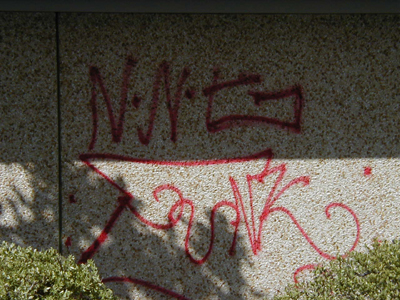
What is Graffiti
Graffiti is not just words and symbols sprayed on a wall. Graffiti is an act of vandalism that costs hundreds of thousands of dollars to clean up every year.
If not immediately removed, graffiti sends out the message that "nobody cares" about the area. It causes the area to look unsafe and makes people concerned about their personal safety. This creates an open invitation for more littering, loitering, and other graffiti. As a result of graffiti, pride in a community may decrease, businesses may suffer, and neighbourhoods as a whole can deteriorate.
Areas filled with graffiti are less appealing to those who may be looking to buy or rent property. Property becomes more difficult to sell and values are reduced.
Graffiti, done without the owner's permission is not art, it's a CRIME!

Graffiti Removal
Graffiti has become more and more prevalent in our modern society. Removal of this "art" is difficult and costly through just about any conventional method. Soda Blasting provides a viable alternative to these methods. As it is non-abrasive, it can be used to remove graffiti from painted surfaces normally without damaging the base paint. This method allows graffiti to be removed from sensitive surfaces such as wood, brick, marble, glass, and sandstone without leaving any evidence of its use behind. Naturally, the operator must take care when setting the pressure, media flow and airflow as damage can still occur from improper settings. We normally test on a non-visual area to ensure our settings are correct.
Soda blasting is an environmentally friendly way of removing paint, dirt, coatings, and other surface contaminants that will not cause damage to the surfaces being cleaned.
Soda blasting is a non-abrasive action. The action of sodium bicarbonate will not cause heat build up, sparks, or abrasion to the surface being cleaned.

Advantages of Soda Blasting
Soda blasting is an environmentally friendly way of removing paint, dirt, coatings, and other surface contaminants that will not cause damage to the surfaces being cleaned.
Soda blasting is a non-abrasive action. The action of sodium bicarbonate will not cause heat build up, sparks, or abrasion to the surface being cleaned.
Soda blasting was developed by New York State engineers looking for ways to clean and restore the Statue of Liberty. They had many concerns involving issues of the environment, waste disposal, and protection of the Statue of Liberty itself. Use of any abrasive material to clean the surface would have been harmful to the soft copper plates. Used blast media waste in the surrounding water was also a concern. Soda blasting was created because it would not only do the job while having a minimal impact on the waterways and harbor but it was also non-abrasive.
Reduced Clean-Up Costs
Soda blast media performs roughly the same level of work (somewhat slower) as sand blasting while producing 1/5 to 1/7 of the total waste volume. Although media costs per square foot are higher, site clean-up and residue disposal are significantly lower. The net balance is that total cost per square foot are about the same for both approaches.
Benefits In Waste Disposal
In most non-hazardous applications, the residue from blasting with Soda can be rinsed into sanitary drains or sewers which flush the residue to a water treatment facility, greatly reducing the clean-up time. Sodium bicarbonate is actually beneficial to waste water treatment systems.
For industrial treatment systems, where chemical neutralization is a major cost in water treatment, Soda blast media can often save significant dollars in waste treatment.
Increased Worker Safety
The safety of sodium bicarbonate to workers is well understood, since it has been in use for some 160 years. The bicarbonate buffer system is the major extracellular buffer in the human body, thus sodium bicarbonate is part of the body's normal chemistry.
Sodium bicarbonate and thus, Soda Blasting is not toxic via ingestion, inhalation or dermal contact, nor is it a skin or eye irritant as defined by EPA and OSHA. Any risk to workers is primarily the containment or coating removed during the blasting operation.



